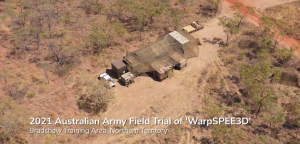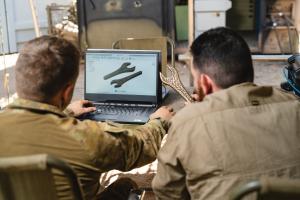SPEE3D has been working with the Australian Army to test metal 3D printing as a military capability. The latest field trial is the longest and toughest yet.
CASUARINA, NT, AUSTRALIA, September 9, 2021 /EINPresswire.com/ -- Australian company, SPEE3D, has been working with the Australian Army to test and validate metal 3D printing as a military capability. The latest field trial is the longest and toughest yet, taking place in remote Northern Territory, alongside exercise Koolendong.The Australian Army is rapidly developing their metal manufacturing capability with SPEE3D?s award-winning metal 3D printing technology. The Australian Army announced a $1.24 million investment in a pilot of SPEE3D technology in February 2020 with a 12-month trial of the WarpSPEE3D Tactical printer. The trial was designed to test the feasibility of deploying metal 3D printing as a capability both in barracks and in the field. The WarpSPEE3D Tactical printer uses patented cold spray technology that enables significantly faster and more cost-effective metal part production than any other process. It can print large metal parts up to 40kg at a record rate of 100grams per minute.
A number of field trials in 2020 resulted in over fifty case studies of printable parts and demonstrated that SPEE3D?s WarpSPEE3D printer was robust enough to operate in remote Australian bushland and the program was extended in 2021 to verify initial results.
This year SPEE3D has been working closely with Army to train the first military Additive Manufacturing Cell (AMC) technicians who specialise in the production of 3D metal printed parts, from design to printing, machining, heat treatment and certification. In the remote bushland of Bradshaw Training Area, located in the Northern Territory, the AMC and SPEE3D recently tested the WarpSPEE3D Tactical printer as part of its toughest trial yet. The printer was transported over 600 kilometers from base, over rough terrain, to operate in hot and dusty conditions for three weeks.
?Last year's trial proved SPEE3D technology was deployable. This year's trial extension is bigger, longer and more remote, making it the worlds? toughest and longest metal 3D printing trial so far.? said SPEE3D?s CEO Byron Kennedy.
Over three weeks, the team are producing metal parts for the M113 armored personnel carrier which is a vehicle that has been used by the Australian Army for over 40 years. The aim of this year?s trial is to prove metal 3D printing can produce high-quality, military grade parts that can be validated and certified for use in the field. The success of this trial will demonstrate that Additive Manufacturing plays an important part in the future of Defence readiness.
As the program continues, the AMC will explore more components that can be repaired and replaced using metal 3D printing and assess how this technology may eventually fit into Australian Army infrastructure.
Amy Frost
SPEE3D
amy.frost@spee3d.com
Visit us on social media:
Facebook
Twitter
LinkedIn



